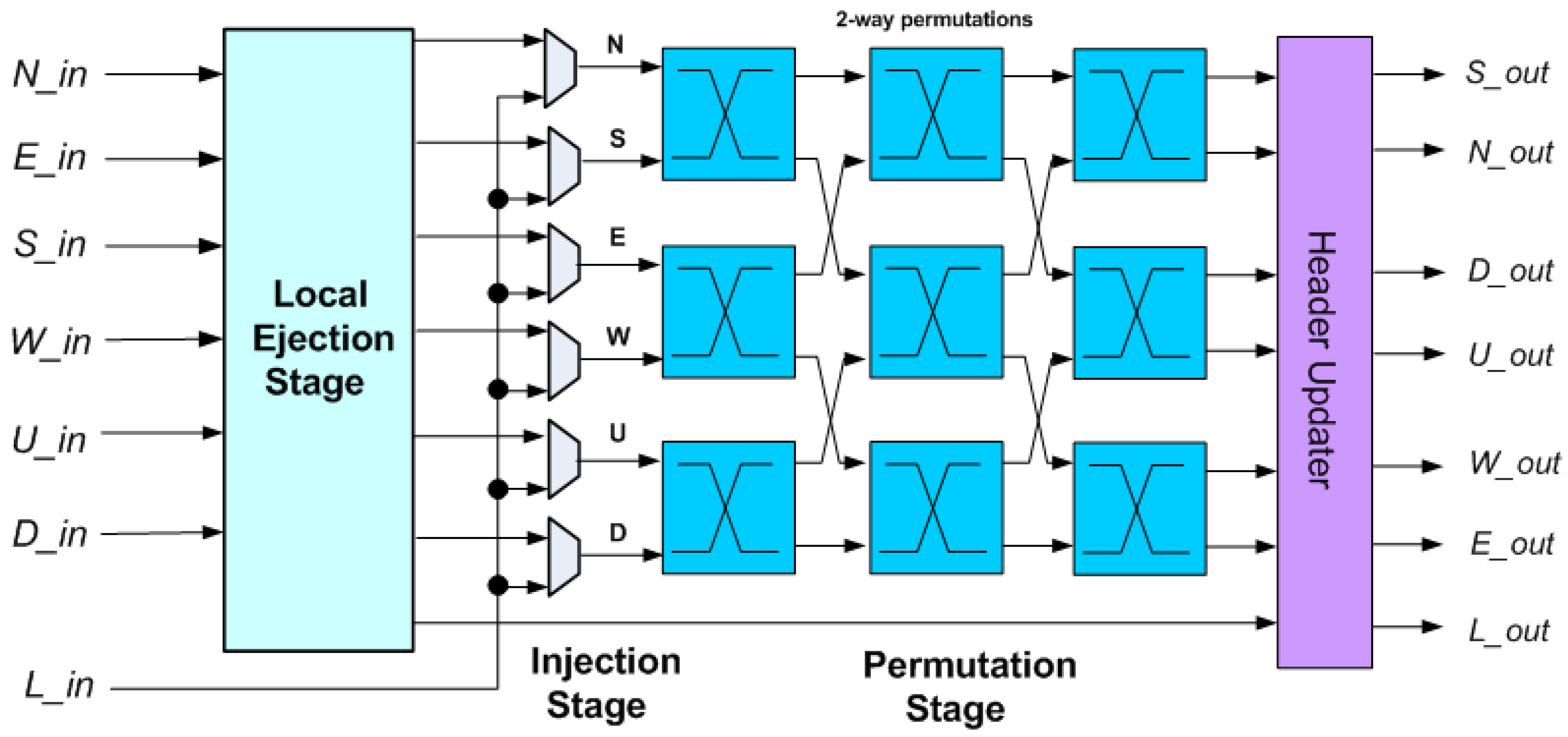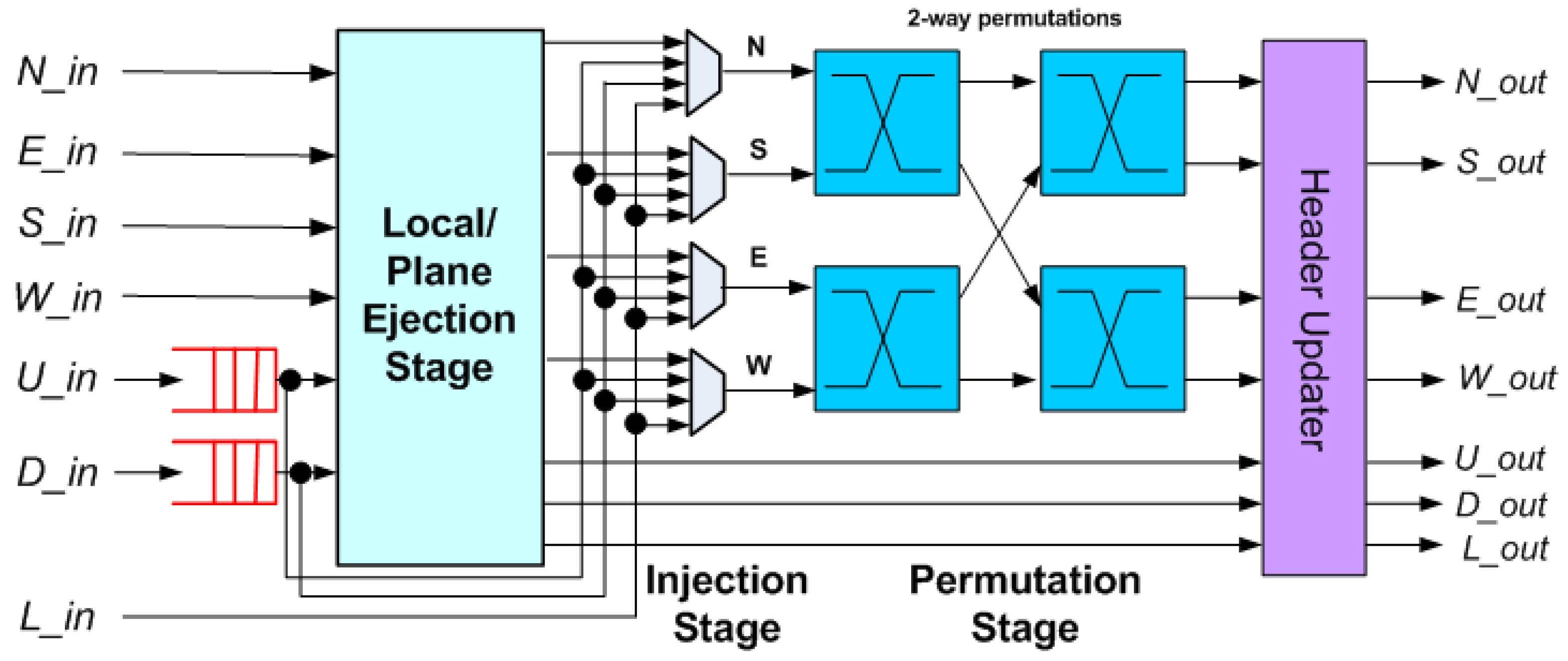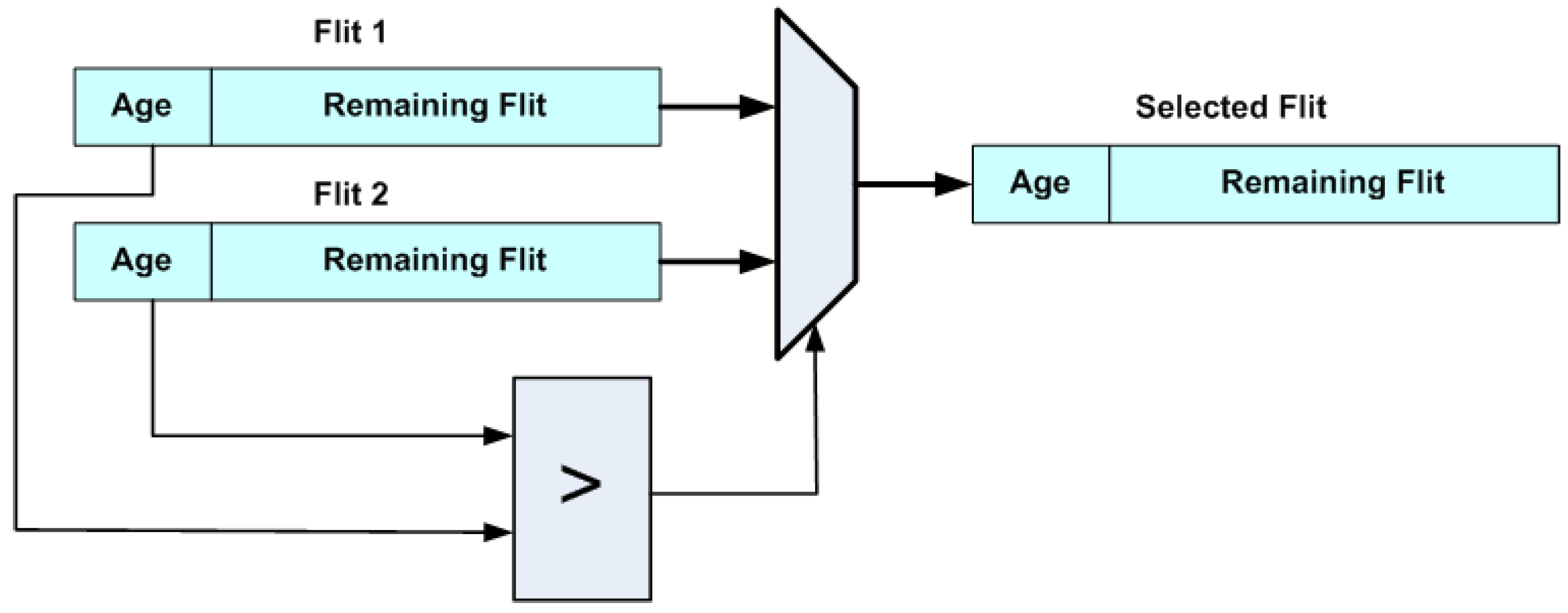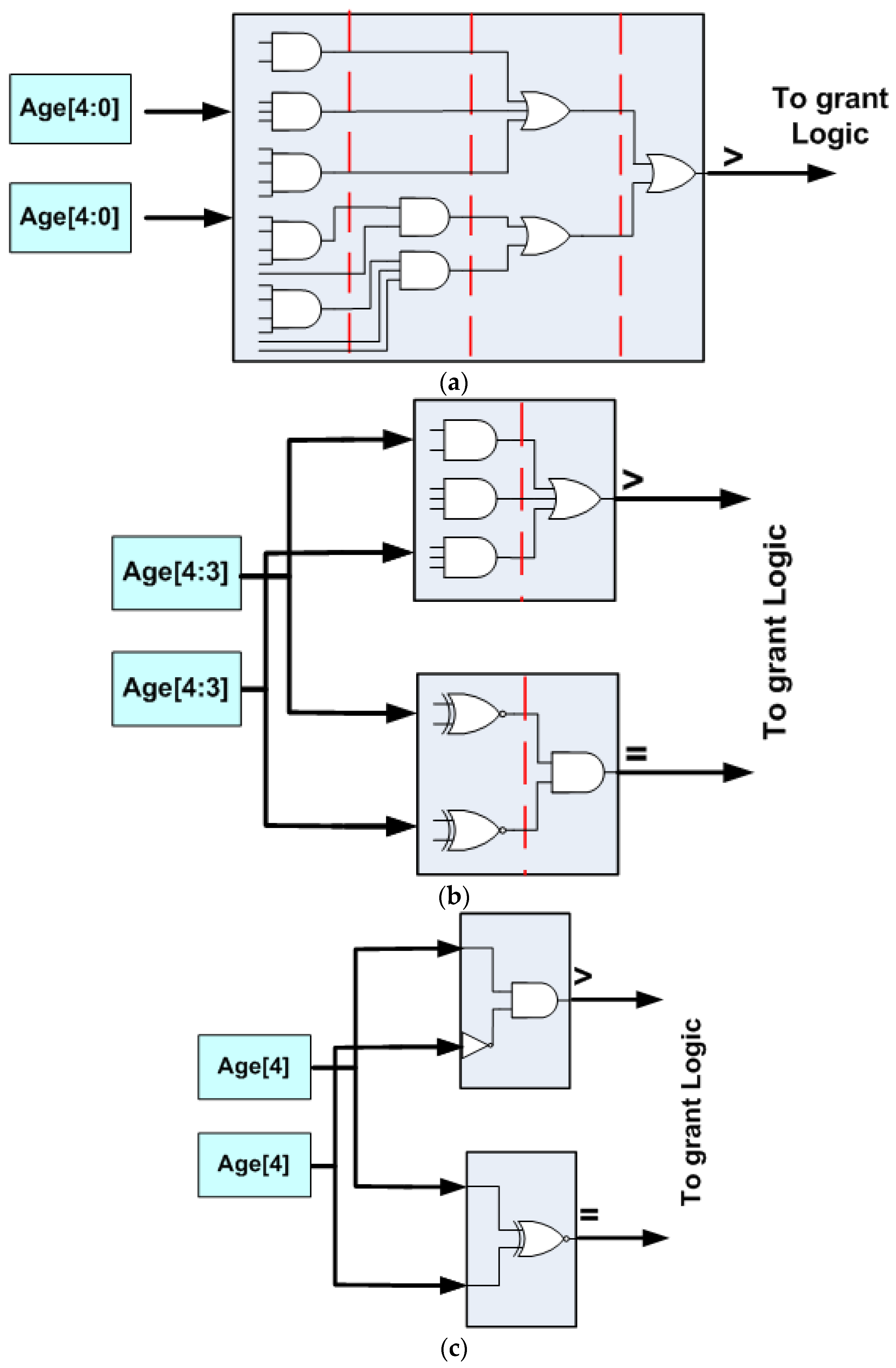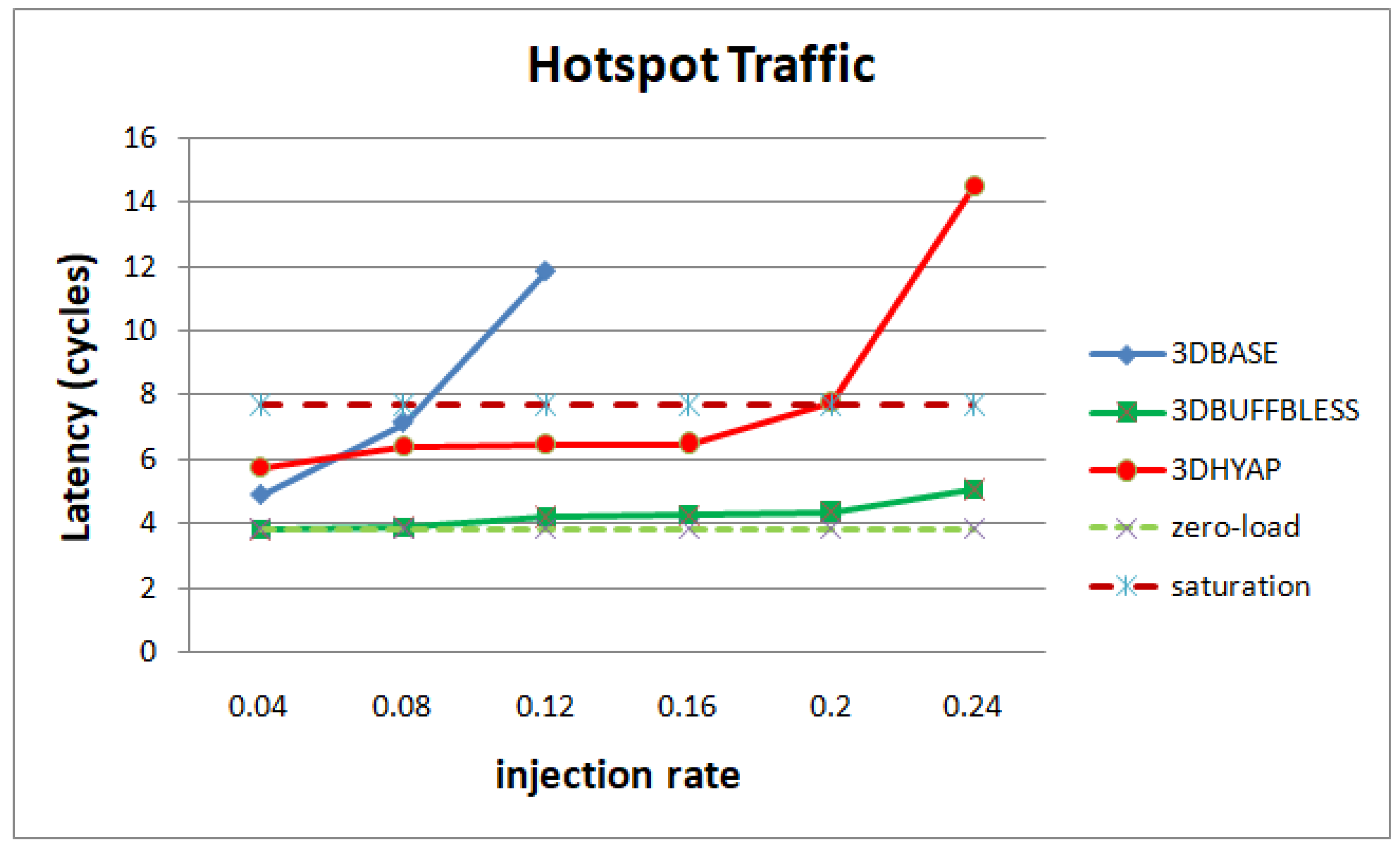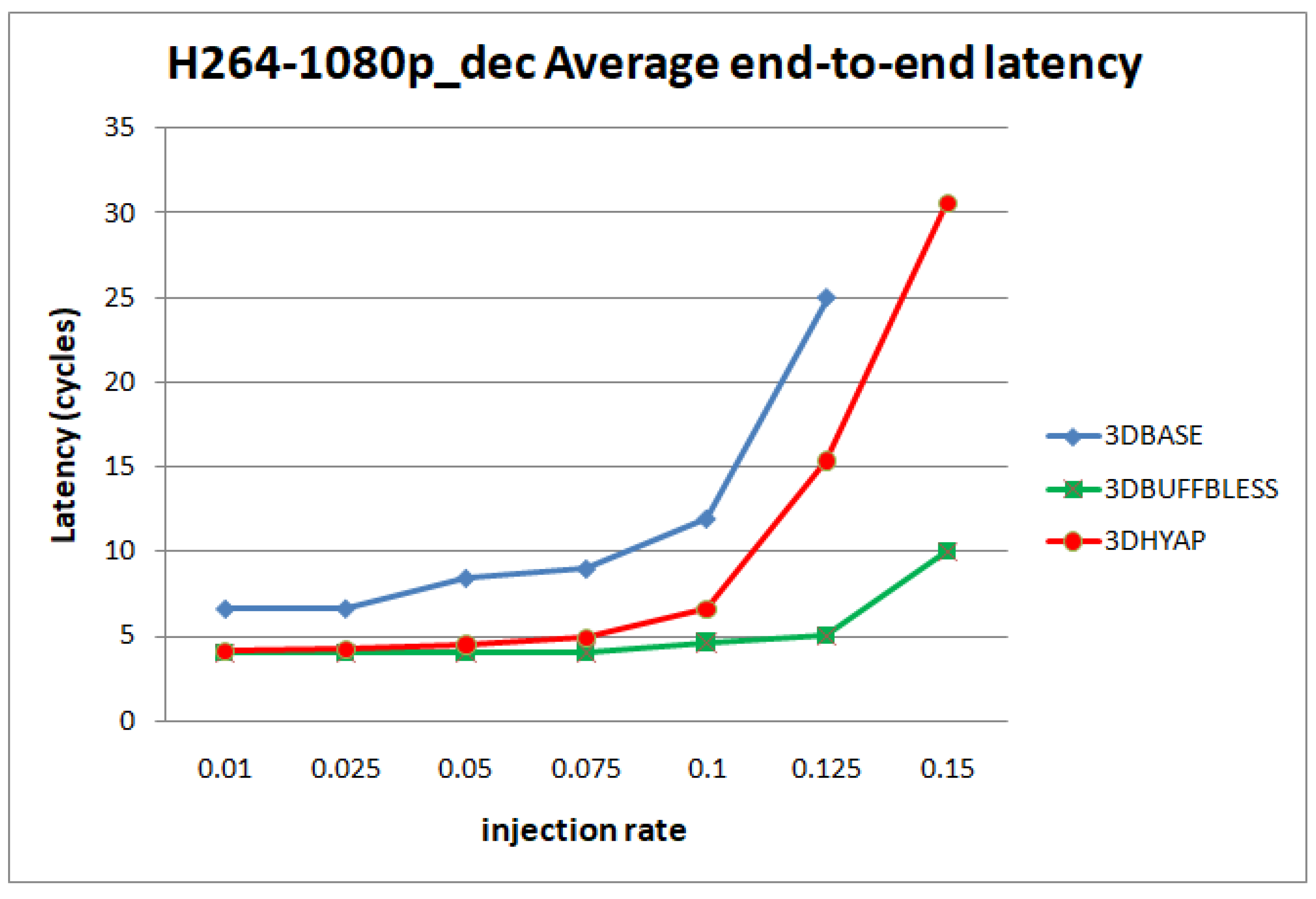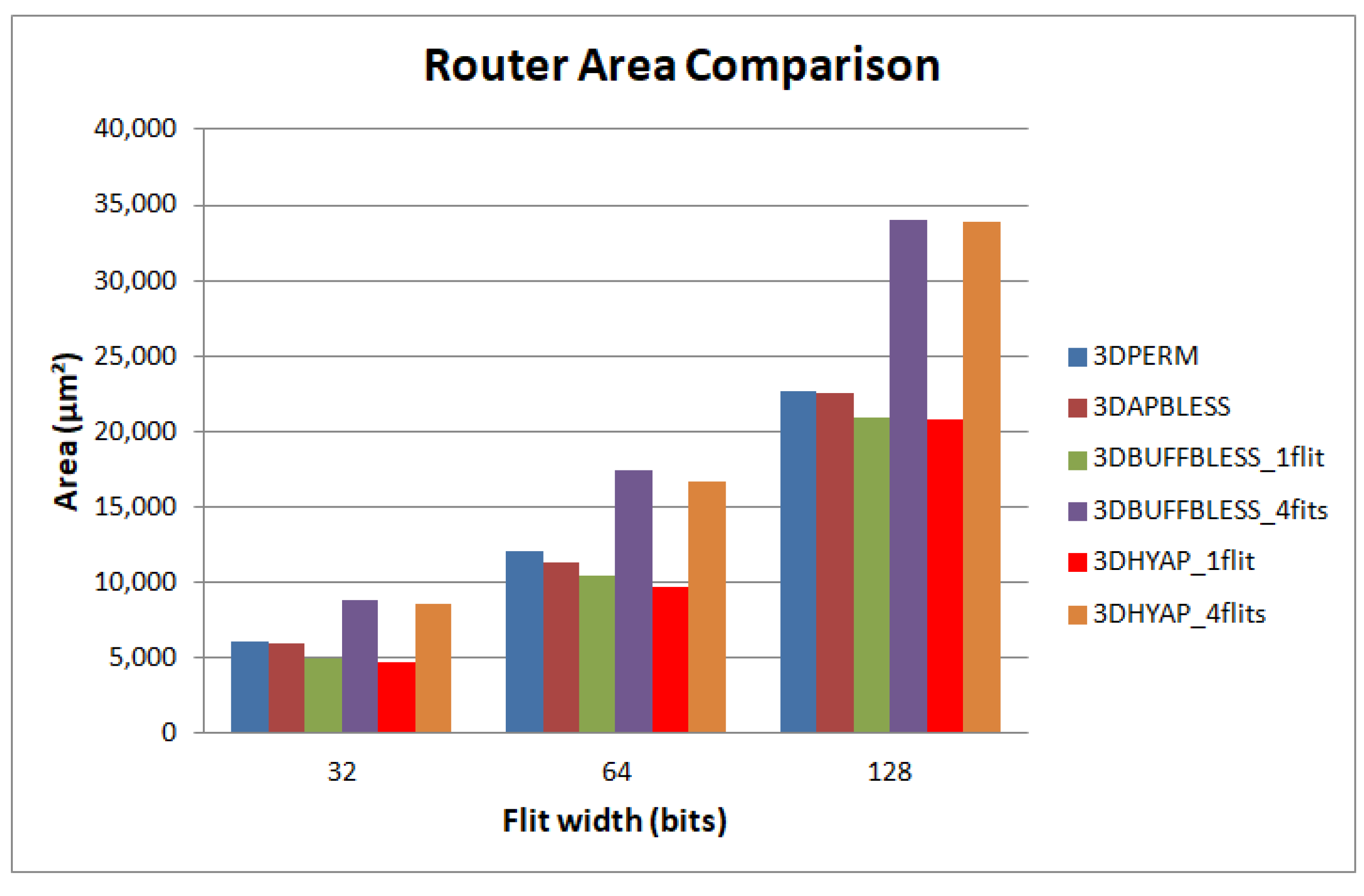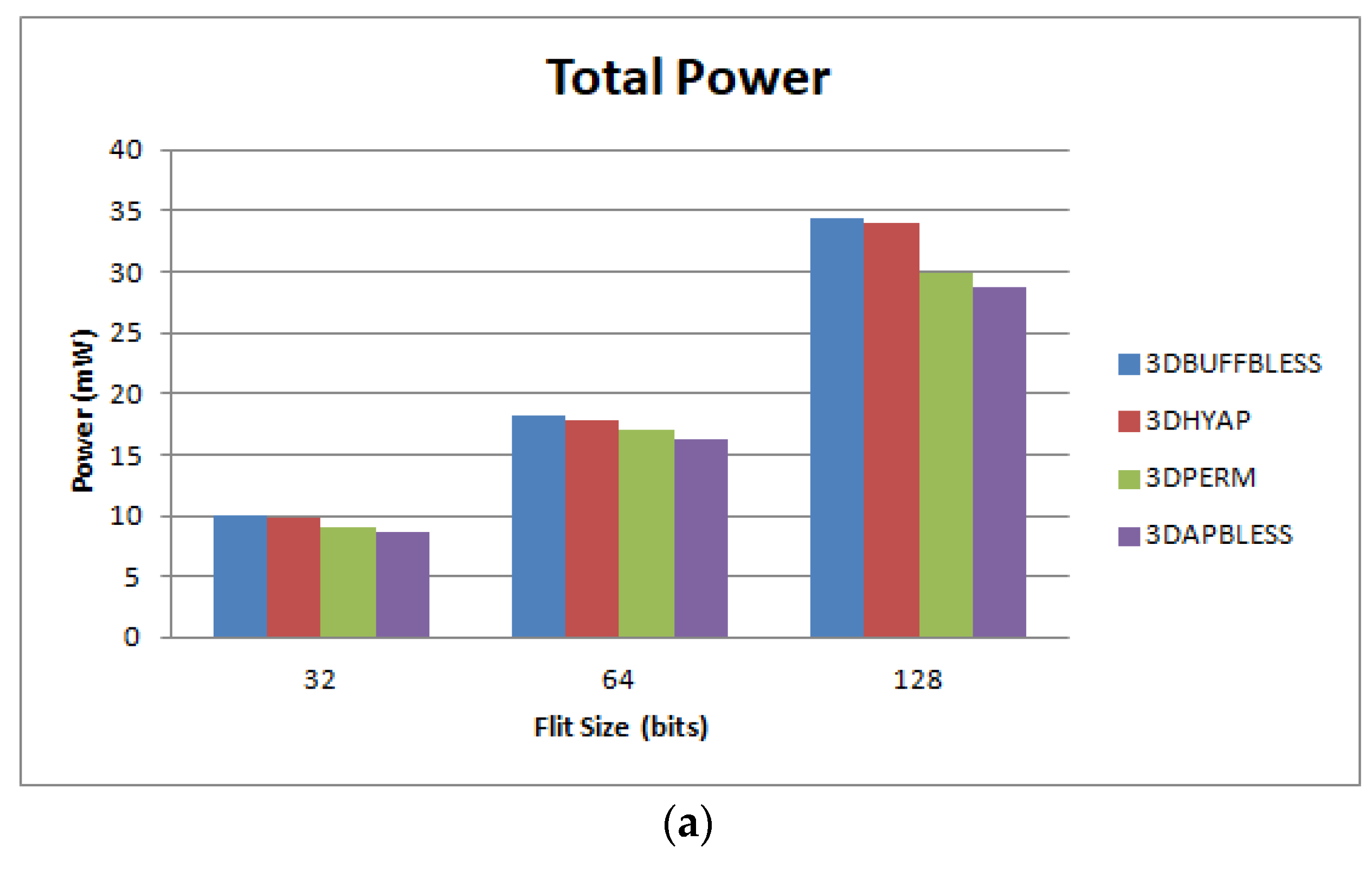1. Introduction
As power and heat density limited the growth of clock frequencies compared to the prediction of Moore’s law, the dominant design paradigm for processors became the multicore architecture. At the same time, this exchanged the power density problem with the core communication challenge. Networks-on-Chip was proposed as a scalable solution providing the communication bandwidth required by multi and many-core architectures with acceptable area and power consumption [
1]. The advance of 3D integration provided an additional incentive, since 3D integration combined with NoCs led to the emergence of 3D NoC architectures [
1]. A key element in the NoC is the router, which is responsible for forwarding packets through the network, since it has strict requirements for performance and reliability in the aggressive scaling of CMOS technology [
2].
Original NoC routers were on-chip implementations of interconnection network routers with little regard for the unique conditions and stringent requirements imposed by the on-chip environment [
1,
3]. The block diagram of such a router is shown in
Figure 1. Typical router parameters that depend on network conditions and influence performance, area and power consumption, are flit size, flits per buffer and number of virtual channels. A routing table or a simple logic-based routing technique is used for routing calculation. Typically, each input port has its own private buffers with a number of Virtual Channels (VCs) used to prevent deadlock. The number of input and output ports depends on the topology. A common instance of the router in
Figure 1 is a five-port version for 2D mesh and torus topologies.
Later studies considered the distinctive features of the on-chip environment driven by Moore’s law, which led to efforts to optimize the buffers in the router, since they were identified as the power and performance bottleneck. On the other hand, unlike the off-chip environment, wide flits are easy to implement on-chip, leading to higher parallelization.
When buffering is insufficient, NoCs can incorporate hot-potato routing or deflection routing: deflecting flits when buffered slots are unavailable. An extension of this was the even more radical suggestion of completely bufferless routing; in other words, forwarding flits to either the desired port or deflecting them, but never locally storing them in the router. This approach trades off routing efficiency (since some flits follow non-minimal paths due to deflections) for router area and power consumption due to the elimination of buffers. The later development of 3D integration led to adapting the routers originally proposed for 2D NoCs to 3D topologies.
3. Proposed Hybrid Approximate Priority Router Design
The above innovations presented in [
17,
20] are essentially orthogonal, a fact that naturally leads to combining the two into a single router, exploiting the advantages of both. The proposed router, named 3DHYAP for a 3D Hybrid Approximate Priority Router, is based on the design in
Figure 4, augmented with the approximate priority comparison of [
20]. The proposed router combines the low cost of bufferless routing, augmented with approximate priority comparison, with the increased routing efficiency of partially buffered routing. In order to minimize hops on the vertical links (TSVs), the proposed router, like 3DBUFFBLESS, features buffering in the up and down ports and no buffering in the ports lying on the same plane. This allows a flit to quickly traverse the chip layers without being deflected, while minimizing the router buffering to only two of the total seven ports.
The reason the z direction was selected for buffering was the asymmetry imposed in the z dimension at the silicon level by the vertical links. Two of the most common ways for implementing vertical links, namely through silicon via (TSV) [
23] and near-field inductive coupling (NFIC), impose an area overhead and also introduce errors and failures, reducing yield. Therefore, designers often choose to reduce the number of vertical links, leading to irregular, partially connected 3D architectures [
24] (not a full mesh). This includes the wireless vertical link 3D NoCs in [
25,
26]. Of course, essentially, the design is dimension-agnostic, and the final floorplanning and layout connecting routers together selects which dimension the buffering is connected to. Any dimension can be selected for buffering without any HDL source code modification.
Since a packet may traverse the z dimension of the network, similarly to wormhole routing, but may have its flits deflected to different directions when moving in the xy plane, bufferless routing mechanisms such as livelock prevention and flit reordering are still required. However, with no horizontal buffer connections, deadlock is not an issue in a network composed of 3DHYAP routers, because buffered cyclic paths cannot be formed. Therefore, virtual channels are not required, simplifying the design of 3DHYAP.
The bufferless part of the router is based on a two-stage permutation network, as shown in
Figure 4, but the selector and permutation blocks use approximate priority comparison.
3.1. Quantitative Analysis
The proposed design can be quantitatively analyzed using simple, back-of-the-envelope calculations and the experimental results in
Table 1 and
Table 2. When it comes to performance, we expect the permutation network delay to be reduced by one third because it will have two stages instead of three. Since the contribution of the permutation network to the critical path is 71% in 3DPERM, according to Ahmdal’s law we expect an improvement of:
In other words, we expect a reduction in delay and an improvement in clock frequency by 23.66% by the reduction in permutation stages. We expect an additional improvement by reducing the complexity of each permutation block by using approximate priority comparison.
In terms of area, the area gains obtained by having four instead of nine permutation blocks will be partly offset by the increased size of the injection/ejection stage, which now will have approximately three times the area of the original. Therefore:
Therefore, we expect an area reduction of approximately 20%. We should have additional area gains from the approximate priority comparison that will be partly offset by the addition of buffers. Clearly, the final area gains will depend on buffer size, and we explore this in the hardware evaluation section.
Integrating a buffered and a bufferless router in a seamless way proved challenging in the case of 3DBUFBLESS, and adding approximate priority comparison requires additional appropriate modifications made to the buffered and bufferless baseline router design, as discussed below.
3.2. General Considerations
Similar to 3DBUFBLESS, 3DHYAP features two additional injection and ejection ports on the router datapath in addition to the local port. Essentially, the up and down ports (buffered ports) are similar to the local port. Therefore, the ejection/injection stage is modified to contain three ports instead of one. Consequently, up to three additional flits may be injected into the bufferless part of the router at the same time (from the U_in, D_in and L_in ports). For this purpose, there are three stall signals, one for each port. This indicates the following possible conditions:
No deflection output ports are available: This condition occurs when there are already four incoming flits from the bufferless input ports and neither is to be ejected. Then, since all incoming flits from bufferless ports must be assigned an output port, no buffered flits can be injected until the next clock cycle.
There is one available deflection output port: This occurs when there are three requests from incoming flits arriving from bufferless ports that are not ejected. In this case, we make the following distinctions: if one of the ports requesting injection is the local port, then it is granted and the other(s) port (up or down) is/are stalled. This is meant to ensure that flits are injected to the network as soon as possible. If the only ports requesting injection are the up and down ports, we decide between the two flits based on their age.
There are two available deflection output ports: In other words, there are two requests from incoming flits that are not ejected. In this case, up to two flits can be injected. In the case of all three injection ports making a request, the one flit granted is the local port’s, and the other one is selected from the other two based on age.
There are two or more flits to be ejected, with at least one from a bufferless input port: In this case, a flit from a bufferless port is selected for ejection, so as not to be deflected. If there is more than one, the oldest is selected.
There are two flits to be ejected, both from the buffered ports: One flit is selected according to age, the other remains buffered until the next cycle.
3.3. Priority Classes and Rules
The above considerations are formalized in the following eight ejection/injection rules, which resolve priority of the various types of incoming flits for ejection and injection. The first six also apply to 3DBUFFBLESS, with the last two added because of the approximate priority comparison:
If two or more flits incoming from the bufferless ports request ejection to a local, up or down port, the flit with the highest priority wins, while the rest are injected into the permutation network.
If an incoming flit from a bufferless input port competes for an ejection port with an incoming flit from a buffered input port, it is ejected while the other remains buffered, and waits for the next cycle.
If two incoming flits from buffered ports compete for an ejection port, one is selected according to rules 7 and 8, the other remains buffered.
Incoming flits from bufferless ports win over flits trying to inject from the local and up/down ports, which remain buffered.
If two or more injection ports are competing, then the local port wins over the up/down ports.
If the up and down ports are competing for injection, then rules 7 and 8 apply.
A flit in an “older” age class has priority over a younger flit.
Two flits belonging to the same age class are permuted in a permutation block, or one is pseudorandomly selected in a selector block.
Therefore, we distinguish between two priority classes: priority of an input port over another input port, and of a flit over another flit.
The priority of ports is resolved first and, if it is equal, then the priority of the individual flits is taken into account. We distinguish between three classes of ports: bufferless input ports (N, S, E, W), buffered input ports (U, D) and the local port (L). For injection, the set of input ports competing are (L, U, D), while, for ejection, the set of ports competing are (N, S, E, W, U, D). Then, the priority of the port classes is as follows:
Priority between flits is resolved using the following rules:
Ejection: Bufferless ports have higher priority than buffered ones
Injection: The local port has higher priority than the up and down ports
The rationale behind the ejection priority rule is to prevent flits from bufferless ports from being deflected when reaching their destination or wish to change layer, while flits from buffered ports can simply wait for the next cycle.
The ejection rule enforces “hot-potato” routing for flits that cannot be buffered, while the injection rule ensures that flits are quickly injected to the network and not “trapped” at the source for long. Since there are equal bufferless input and output ports, incoming flits from bufferless ports cannot be dropped. The only case when flits may be dropped is in the case of buffer overrun in the buffered ports.
3.4. Buffered Port Design
The injection/ejection stage is shown in
Figure 5. There are two similar ejection ports for the up and down directions, which have the local port as input. This incurs no significant performance penalty since the three ejection paths operate in parallel.
3.5. Injection/Ejection Stage
The ejection stage selects, at most, one flit to be assigned to each of the ejection ports, U_out (up direction), D_out (down direction) and L_out (local port), based on priority while forwarding the remaining flits to the injection stage. As shown in
Figure 5, the ejection stage is composed of three trees of flit selector blocks. Each selector accepts two flits as inputs and outputs the one with the highest priority, as shown in
Figure 6. This way, the flit with the highest priority that has reached its destination is selected for ejection to the L_out port, while the flit with the highest priority that wishes to exit to the upper layer is forwarded to U_out, and likewise to the D_out for the lower layer. The remaining flits are either forwarded to the injection stage or remain buffered.
3.6. Approximate Priority Permutation Network
A permutation block is similar to a selector block, but requires two multiplexers instead of one as it permutes two flits, as shown in
Figure 7. If the incoming flits are requesting different outputs, they can both be granted their request. However, when they both request the same output, either U_out or D_out, the one with the highest age field value wins, and the other is deflected to the other permuter output.
3DHYAP adopts the approximate comparison logic of 3DAPBLESS [
20], where the magnitude comparator is replaced with simpler logic that compares a subset of the bits in the age field of the competing flits. By only comparing the most significant bits, 3DHYAP essentially separates the flits as belonging to crisp “age classes”.
When competing flits belong to the same age class, they are pseudorandomly permuted. We use a single 16-bit PSRNG, with one bit feeding each of the permutation and ejection blocks. We demonstrate two approximations, as shown in
Table 3, using the two most significant bits, and using only a single most significant bit. Using two bits separates flit ages into four classes, while using only one separates them into two. Essentially a flit with an MSB of 1 in the age field is classified as “old”, while a flit with an MSB of 0 is classified as “young”.
In our evaluation section, we consider a 4 × 4 × 3 mesh NoC. In this case, the maximum internode distance is eight hops. Since a reasonable age field would include at least double that number, we use five bits in our design (
Figure 8a). Similar to [
20], we have experimented with two versions of 3DHYAP, one using the two most significant bits of the age field and one using only one, which we term 3DHYAP_lite.
We next attempt to estimate the additional performance improvement achieved by the approximate priority comparison.
Figure 8a shows the magnitude comparator for a 5-bit age field (inverters not shown). As can be seen, after breaking down the logic to four-input logic gates at most, four levels of logic are required. In
Figure 8b, the equivalent circuit with a 2-bit priority field is shown, which requires only two logic levels for each magnitude comparator (again, inverters are not shown). The proposed approximate priority magnitude comparator now requires both the greater than and equal outputs to decide whether to deterministically or pseudorandomly route the packet; however, these operate in parallel. Finally, in
Figure 8c, the equivalent logic using only a single bit for classifying packet age is shown, leading to a single level of logic.
The above can be used together with the circuit diagram in
Figure 7 to estimate the improvement in the critical path timing. The request logic of the permutation block requires two logic levels, the grant logic requires two logic levels, since it is a 3-bit boolean function, as shown from the table in
Figure 7, and the two-to-one multiplexer requires two more levels of logic. Therefore, the original permutation block requires a total of eight logic levels and the 2-bit priority field permutation block requires six. The 1-bit priority field is expected to also require six logic levels, since the delay will be dominated by the request logic, which still requires two logic levels and operates in parallel with the magnitude comparator. However, it should provide additional area if not performance gains.
We also expect a reduction in the delay of the selector blocks used in the ejection/injection stage, this time from five logic levels in the original one, to three and two for the 2-bit and 1-bit priority fields, respectively. Since, according to
Table 2, the ejection/injection stage accounts for 9.1% of the critical path delay, we can estimate the performance gains by modifying Equation (1) to take this additional analysis into account:
In other words, we expect an additional improvement of 15% from the reduced complexity of each permutation block for a 2-bit priority field. Similarly, for a 1-bit priority field:
4. Experimental Results—High Level Simulation
For presentation purposes, we divide the evaluation section into the high-level simulation results and the hardware implementation results. The high-level simulations explore the latency in hops under various traffic conditions, while abstracting away irrelevant hardware details, while hardware implementation is used to obtain clock frequency and area and power consumption figures. We then present combined evaluation results that calculate the latency in nanoseconds using a combination of the latency in cycles obtained by high-level simulation and the clock frequency, respectively, obtained from hardware implementation. We considered a single-cycle router in order to achieve a fair comparison between the proposed router and previous work, since many bufferless routers proposed in previous work [
15,
16] are single-cycle routers, which is not a coincidence, since low latency in NoCs is as important as high throughput, and therefore, deep router pipelines are prohibitive. It would also be unfair to compare single-cycle routers with a pipelined proposed design. Therefore, we implemented all routers as single-cycle, only registering the outputs. Considering a number of N pipeline stages, equal for all routers, then the latency of all routers presented in the following subsections, shown in
Figure 8,
Figure 9,
Figure 10,
Figure 11,
Figure 12 and
Figure 13, would be multiplied by the pipeline stages (assuming no pipelining in the links), and therefore, the figures would be almost identical, scaled by N. Furthermore, in
Figure 14,
Figure 15 and
Figure 16, where the cycle time is taken into account after synthesis, in the case of N pipeline stages, the cycle time would be divided by the pipeline stages (approximately) and the latency in ns would be the same.
The proposed design mainly aims to improve bufferless routing performance while introducing minimal overheads. For that reason, reliability and fault tolerance were not considered. Clearly, methods for addressing transient and permanent faults in both buffered [
27] and bufferless routers [
28] can also be employed in the proposed router (as well as the previous work evaluated), but that is beyond the scope of the proposed work.
4.1. High-Level Simulation Setup
Regarding high-level simulation, we developed cycle-accurate models of 3DBASE, 3DBUFFBLESS, 3DPERM and 3DHYAP in the HNoCs environment [
29]. The simulation was performed on a 4 × 4 × 3 NoC mesh. The simulation duration was 4 milliseconds with a warm-up period of 4 microseconds. Synthetic and realistic NoC traffic patterns were implemented to evaluate the performance of the proposed router. In terms of synthetic traffic patterns, we used uniform random traffic, transpose traffic and hotspot traffic, starting with an injection rate of 0.04 flits/cycle/node and stopping at the network saturation point. In uniform random traffic, each source sends to all destinations with equal probability. In hotspot traffic, each source sends to one of the central routers with a probability of 10%, and with an equal probability to the rest. Finally, in transpose traffic, the source router with coordinates (x, y, z) sends to the destination with coordinates (N_x-1-x, N_y-1-y, N_z-1-z), where N_x, N_y, N_z, are the 3D mesh network dimensions.
4.2. Simulation Using Synthetic Traffic
Figure 9 illustrates the average end-to-end latency per flit in cycles under Uniform Random Traffic (URF). Specifically,
Figure 9a compares 3DBASE, 3DPERM, 3DBUFFBLESS, 3DAPBLESS and 3DHYAP for uniform random traffic. For further clarification, we show the zero-load and saturation latency as defined above. For injection rates less than 0.2 flits per cycle per node, all routers are close to the zero-load latency. It can be seen that the most vulnerable router to saturation is 3DAPBLESS, closely followed by 3DPERM, which begins to saturate at an injection rate of 0.2 flits/cycle/node. These are the bufferless routers using nine permutation blocks, and since 3DAPBLESS misroutes flits more than 3DPERM at high injection rates due to the approximate priority comparison, this result is to be expected.
The next router to begin saturating is 3DBASE at 0.24 flits per cycle per node. This router has very low latency in cycles at low injection rates, since it centrally sorts flits and, therefore, features the fewest deflections among bufferless routers. However, its latency starts rapidly rising after the 0.2 injection point.
3DBUFFBLESS features the lowest saturation overall since it can store some packets instead of deflecting them, but it has a slightly higher zero-load latency. 3DHYAP provides a middle ground between 3DBASE and 3DBUFFBLESS, since it stores some flits like 3DBUFFBLESS, but deflects the remaining flits less efficiently than 3DBASE.
Furthermore, it can be observed that 3DHYAP and 3DBUFFBLESS feature somewhat higher end-to-end latency below 0.2 flits per cycle per node, and significantly lower above. The reason for the higher end-to-end latency in the low injection rates compared to 3DBASE is that some flits spend time stored in the 3DBUFFBLESS buffers, while, in 3DBASE, they are always transmitted in the same cycle. Since the injection rate is low, the deflections are few and that incurs some latency overhead. However, at an injection rate of 0.2 the two routers feature virtually the same latency and, at the higher injection rates, this trend is emphatically reversed with 3DBUFFBLESS featuring significantly lower latency in cycles. This is due to the fact that 3DBASE deflects many flits, while 3DBUFFBLESS can store incoming flits from the up and down ports until a port becomes available, leading to fewer deflections, and thus fewer hops that offset this additional intra-router latency.
3DHYAP and 3DBUFBLESS reach saturation latency at an injection rate of 0.24 hops/flit/node, while the latency in cycles of 3DBASE at the same injection rate is 30% less than that value. 3DBUFBLESS reaches saturation latency at an injection rate of 0.24 hops/flit/node, while the latency in cycles of 3DBASE at the same injection rate is 30% less than that value. Furthermore, as will be discussed in the hardware evaluation results, due to the higher clock frequencies achieved by 3DBUFFBLESS, the gains in latency in ns is approximately 50% of that value.
Figure 9b separately compares 3DHYAP with 3DHYAP_lite (two versus one bit comparison). 3DHYAP_lite shows a slight additional latency compared to 3DHYAP at injection rates above 0.16, since it tends to misroute some flits compared to 3DHYAP, since its priority comparison is less accurate than 3DHYAP.
In
Figure 10, we see the same analysis for hotspot traffic. 3DPERM and 3DAPBLESS saturate very rapidly due to many deflections in the central routers, and are not shown. Hotspot traffic is, as expected, more demanding on the network, forcing hops and latency to increase starting from the low injection rates. This has the effect of 3DBASE featuring higher latency than 3DHYAP almost immediately, the only exception being the very low injection rate of 0.04. 3DHYAP eventually reaches the saturation threshold at an injection rate of 0.2 due to many deflections, while 3DBUFFBLESS reaches saturation after 0.24, proving the least vulnerable to saturation.
Figure 11 presents simulation results for transpose traffic. All router average latencies are close to the zero-load latency injection rates below 0.12. However, 3DBASE reaches the saturation threshold at 0.16, while 3DHYAP reaches it at 0.2, which is a relative increase of the saturation threshold by 25% compared to 3DBASE and 3DBUFFBLESS at approximately 0.22. It must be noted that the differences between 3DHYAP and 3DHYAP_lite, as well as 3DHYAP and 3DBUFFBLESS, for buffer sizes above 1 flit, are imperceptible and are not shown in the diagram for simplicity. This is likely because, at low injection rates, they are very close, but when saturation begins they all rapidly saturate.
From the above diagrams, we can generalize that 3DBUFFBLESS and 3DHYAP feature higher zero-load latency than 3DBASE. However, 3DBUFFBLESS degrades much more gracefully as injection rate increases than 3DBASE, with 3DHYAP somewhere in the middle.
4.3. Simulation Using Real Traffic Patterns
Real data transmission of NoCs is much less regular than synthetic traffic patterns. In order to capture the performance of the proposed router under these conditions, we implemented the Multi-Constraint System-Level (MCSL) NoC Traffic Patterns proposed in [
30] on our 3D design to capture its performance. Due to the long simulation times required, we only compared 3DBASE with 3DHYAP. We used two applications as benchmarks, namely “ROBOT”, which is the Newton-Euler dynamic control calculation for the 6-degrees-of-freedom Stanford manipulator, comprising 88 tasks and 131 communication links, and “H264-1080p_dec”, which is an H.264 video decoder with a resolution of 1080p comprising 5191 tasks and 7781 communication links.
It should be noted that since NoC architectures are used in many applications, from edge applications to big data [
31], we intend the proposed router to be a general-purpose router for 3D NoCs. Therefore, the above benchmarks were only used for evaluation and the proposed architecture was only designed with the limitations of 3D integration in mind and not a specific application. A specific application would likely afford additional optimization in the router, or at the network level; for example, different buffering requirements for the up direction than the down direction, or a preference for deflection, etc.
Figure 12 and
Figure 13 show the average end-to-end latency as a function of the injection rate for the H.264 video decoder application and the Robot application, respectively. In general, the trends observed using synthetic traffic patterns are present here too: 3DBASE reaches saturation first, followed by 3DHYAP, with 3DBUFFBLESS being the last to saturate. One pronounced difference is that 3DBASE features higher latency in cycles from the start, even at very low injection rates.
6. Conclusions
This paper presented an exploration of combining partially buffered routing in the z dimension of a 3D router, with approximate priority deflection routing in the x and y dimensions. From the combination of high-level simulation with hardware implementation, the key results summarized below were obtained:
Firstly, minimal buffering in the z dimension significantly increases the saturation threshold in a 3D mesh topology compared to completely bufferless routing. However, somewhat counterintuitively, additional buffering has minimal effect, as also demonstrated in [
17]. The lower latency is also translated to higher energy efficiency, despite the power overhead imposed by the partial buffering.
Secondly, the reduction of the bufferless routing to four ports instead of six significantly reduces the critical path delay, and therefore, increases the clock frequency.
Thirdly, adding an approximate priority comparison further increases clock frequency and reduces router area at the expense of somewhat lower saturation latency.
Finally, the zero-load latency of the partially buffered routers is somewhat higher than the bufferless ones due to the buffered ports. However, this is likely to be improved by adding pipeline stages, which are left for exploration in the future.
Further considering possible future research directions, we plan to evaluate the proposed router, as well as the counterparts discussed in the paper, in terms of reliability and fault-tolerance using gate-level reliability estimation tools, such as those proposed in [
33]. In fact, to the best of our knowledge, such an analysis and comparison between buffered and bufferless routers has not yet been attempted.


